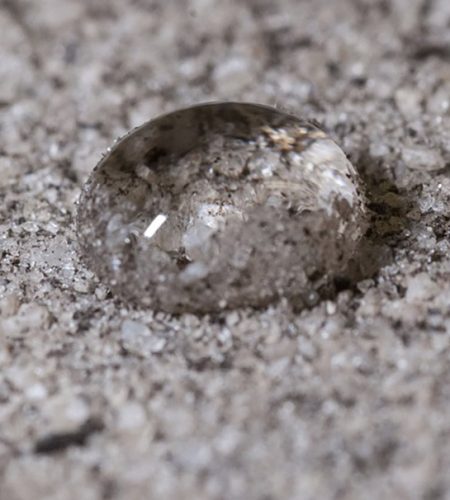A fact sheet to support the Soil CRC’s ‘Soil water repellence’ webinar, delivered as part of our ‘Building technical capacity for improved soil management’ webinar series.
In this webinar, Murdoch University Professor and Soil CRC Project Leader, Dr Richard Bell , presented a comprehensive lecture on water repellence using a presentation developed by PhD student Simon Yeap who is participating in the Soil CRC’s ‘New amendments for sandy soils’ project.
Water Repellent Soils
Sandy soils are common across much of the grain growing regions in southern and western Australia. Nearly 10 million hectares of this land is affected by water repellence. Water repellent soils prevent normal infiltration of water, which either pools on the surface and evaporates, or moves down ‘preferred pathways’ leaving large volumes of soil dry. Uneven wetting of soils causes poor germination of crop, pasture and weed plants and increased risks from wind and water erosion.
Water repellence occurs when hydrophobic (water repellent) ‘skins’, made from plant waxes and other products from the natural process of plant biodegradation, form around individual sand grains. These waxy skins effectively repel water from the soil and limit water availability to the crop (Source: CSIRO). Water repellence tends to be most severe during the summer and early autumn, but it can vary throughout the seasons.
Estimated losses for crop and pasture production due to water repellent soils exceed $100M a year (Source: CSIRO).
Assessing Water Repellence In The Field
Water repellence can be tested using one of two methods:
- The water droplet penetration time (WDPT) test measures how long the soil remains repellent in the presence of water. This may take longer than 3 hours for very repellent soils.
- The molarity of ethanol droplet (MED) test measures the severity/degree of water repellence.
Factors Influencing Water Repellence
Water repellence is commonly observed in sandy soils, where only a small percentage of sand grains need to be coated with water-repellent organic matter to hinder water infiltration. The balance between polar and non-polar compounds in the outermost layer of organic matter plays a crucial role in causing water repellence. While microbial activity in the soil can have both positive and negative effects, certain bacteria and actinomycetes can decompose hydrophobic compounds, potentially mitigating water repellence.
Farming practices, such as dry sowing, can exacerbate the issue, leading to challenges with crop emergence.

Water Harvesting And Banded Wetting Agent
Farmers are adopting water harvesting techniques and using a banded wetting agent in the sowing row behind the press wheel. This approach aims to obtain the beneficial effect of the banded wetting agent while reducing costs by using less wetting agent.
Managing Water Repellence In Soils
Various amelioration and mitigation strategies have been developed, but their effectiveness varies based on locations and soil types. Amelioration involves changing soil properties to remove repellents, such as deep soil cultivation to dilute or bury repellent topsoil.
Claying is a technique used to enrich the surface soil with clay, particularly in very poor sandy soils that have a low clay content. This process involves bringing clay from the subsoil closer to the surface, where it can be mixed into the topsoil. Different methods, such as spading, inversion tillage, deep ripping, delving, and clay spreading, are employed to achieve this. Testing the clay’s properties is essential to determine its suitability.

